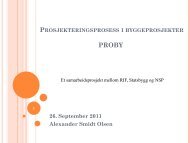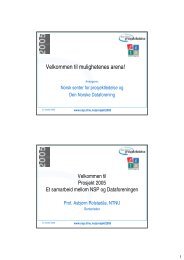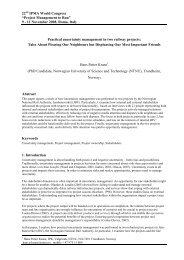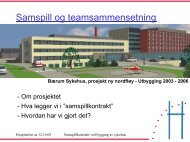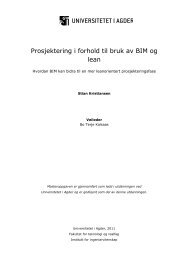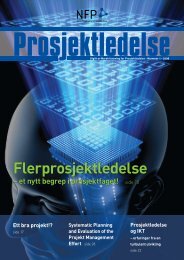positive vs negative iteration in design - Lean Construction Institute
positive vs negative iteration in design - Lean Construction Institute
positive vs negative iteration in design - Lean Construction Institute
You also want an ePaper? Increase the reach of your titles
YUMPU automatically turns print PDFs into web optimized ePapers that Google loves.
Ballard IGLC-8 3Figure 1: Handoff ControlThird, variability of outcomes has opposite valuations. In mak<strong>in</strong>g, variability of outcomesis not desirable 2 . This follows quite closely from the concept of quality as conformance torequirements. Requirements are established, then someth<strong>in</strong>g is made and evaluated forconformance 3 . By contrast, if <strong>design</strong> products were perfectly predictable, the <strong>design</strong>process would not be add<strong>in</strong>g value. Re<strong>in</strong>ertsen (1997, p.71) goes so far as to argue for thebenefits of <strong>design</strong> (test) failures because they contribute the most <strong>in</strong>formation regard<strong>in</strong>g<strong>design</strong> problems and possible solutions. This raises questions about <strong>design</strong> processcontrol, some of which have previously been addressed by this author (Ballard, 1999a).Fourth and last, <strong>iteration</strong> <strong>in</strong> mak<strong>in</strong>g is usually called "rework" and is clearly a type ofwaste to be avoided. Complet<strong>in</strong>g assigned tasks is a central pr<strong>in</strong>ciple of lean construction,both for the reduction <strong>in</strong> waste <strong>in</strong>volved <strong>in</strong> mak<strong>in</strong>g multiple visits to the same worklocation and for the plan reliability it <strong>in</strong>creases, which has further <strong>positive</strong> impact onproductivity and performance 4 . However, <strong>design</strong><strong>in</strong>g often requires the production of<strong>in</strong>complete or provisional outputs <strong>in</strong> order to develop understand<strong>in</strong>g of both <strong>design</strong>problems and alternative solutions (Lawson, 1997; Re<strong>in</strong>ertsen, 1997; Ulrich andEpp<strong>in</strong>ger, 1999). Design<strong>in</strong>g can be likened to a good conversation, from which everyoneleaves with a better understand<strong>in</strong>g than anyone brought with them. How to promote thatconversation (<strong>iteration</strong>) and how to differentiate between <strong>positive</strong> and <strong>negative</strong> <strong>iteration</strong>would appear to be critical <strong>design</strong> management skills. In the words of Fabio Pimenta 5 ,"Design development makes successively better approaches on the whole <strong>design</strong>, likegr<strong>in</strong>d<strong>in</strong>g a gem, until it gets to the desired po<strong>in</strong>t; while construction happens <strong>in</strong> sequentialphases which br<strong>in</strong>g each part of the object to its f<strong>in</strong>ished state."WHAT IS WASTE IN DESIGN?Assum<strong>in</strong>g that <strong>design</strong> is by its nature an iterative and generative process, how should weunderstand waste <strong>in</strong> <strong>design</strong>? Waste has been characterized by Koskela and Huovila (1997)<strong>in</strong> terms of m<strong>in</strong>imiz<strong>in</strong>g what is unnecessary for task completion and value generation.Consequently, that <strong>iteration</strong> is wasteful which can be elim<strong>in</strong>ated without loss of value orcaus<strong>in</strong>g failure to complete the project. Precisely what <strong>iteration</strong> can be thus elim<strong>in</strong>ated is amatter for empirical research. Informal surveys of <strong>design</strong> teams have revealed estimates ashigh as 50% of <strong>design</strong> time spent on needless (<strong>negative</strong>) <strong>iteration</strong>.There are certa<strong>in</strong>ly other types of waste <strong>in</strong> <strong>design</strong> than <strong>negative</strong> <strong>iteration</strong>. One exampleis <strong>design</strong> errors. Re<strong>in</strong>ertsen (1997, p.78) characterizes <strong>design</strong> outputs as defective whenthey fail because someth<strong>in</strong>g previously known was forgotten or neglected. By contrast,2 However, there is the <strong>in</strong>trigu<strong>in</strong>g possibility of extend<strong>in</strong>g <strong>design</strong> <strong>in</strong>to the mak<strong>in</strong>g process, which certa<strong>in</strong>lyoccurs <strong>in</strong> artistic production.3 Recogniz<strong>in</strong>g that the act of mak<strong>in</strong>g can itself reveal the <strong>in</strong>adequacy of <strong>design</strong>, we should perhaps say thatvariability of outcomes is not desirable, so long as the requirements aga<strong>in</strong>st which variation is judgedare fit for purpose. If requirements are "quality", then conformance to those requirements generatesvalue. It is important to rema<strong>in</strong> alert for opportunities to generate better <strong>design</strong> or requirements even <strong>in</strong>the test<strong>in</strong>g phases of f<strong>in</strong>al assembly.4 Ballard (1999a)5 Private communication (March, 2000) from Pimenta to Ballard comment<strong>in</strong>g on this paper. Fabio Pimentais director of Projetar, a mechanical and electrical eng<strong>in</strong>eer<strong>in</strong>g firm <strong>in</strong> Sao Paolo, Brazil.



